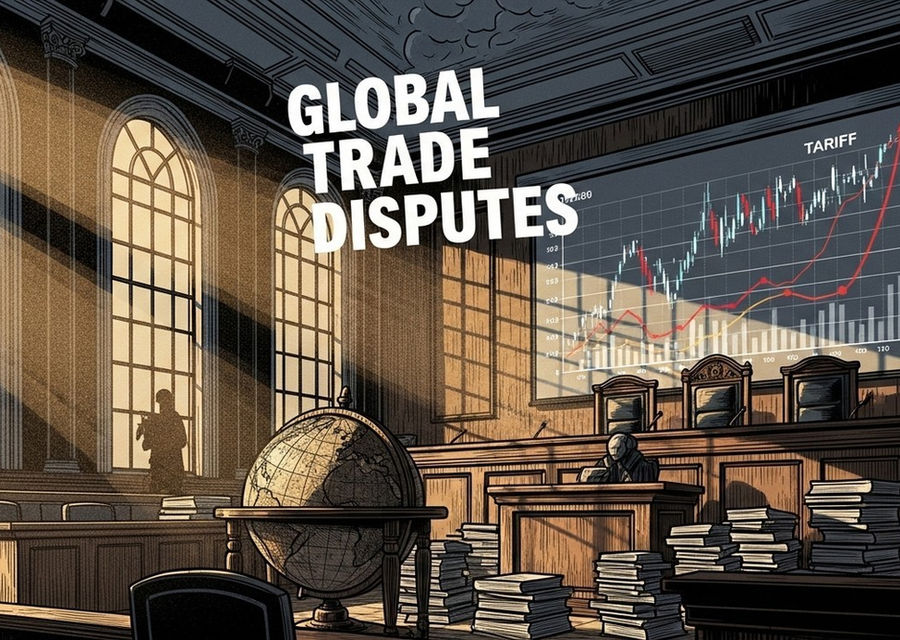Emergency Powers Act Tariffs: Supreme Court Challenge
- THE MAG POST

- Sep 4
- 7 min read

Emergency Powers Act tariffs are redefining the boundaries of presidential authority in the age of global supply chains and strategic competition. This opening moment in a high-stakes legal contest asks whether executive tools designed for emergencies can anchor broad economic policy without unraveling legislative guardrails. As courts weigh text against practice, the world watches to see whether the administration’s approach can withstand judicial scrutiny while preserving the flexibility needed to respond to evolving threats and opportunities.
Can Emergency Powers Act tariffs endure the crucible of the Supreme Court? The question sits at the intersection of constitutional authority, global commerce, and the presidency’s tool kit for shaping economic policy.
Can Emergency Powers Tariffs Survive Supreme Court Scrutiny?
In a moment of escalating global trade tensions, the administration has leaned on a 1977 framework to justify sweeping duties on international goods. Critics argue that the breadth of the tariffs exceeds statutory permission, while supporters contend that the executive branch must act decisively in a shifting geopolitical landscape. The dispute is not merely technical; it tests the very limits of presidential power in bipartisan markets that are deeply interconnected. The outcome could recalibrate how far executive instruments can stretch before Congress checks the compass.
Framed as a national safeguard, the tariffs are analyzed as a strategic resource for domestic industry and national security. Yet the rival view warns of economic distortions, retaliatory measures, and long-term diplomatic frictions that could complicate alliances and investor confidence. The legal fight now moves toward a courtroom stage where precedent, statutory interpretation, and constitutional boundaries will clash in real time.
Legal Boundaries of Executive Authority
The core question centers on whether the president may wield broad emergency powers to tax imports as a lever of policy across many sectors. Legal authorities contend that the invocation must be tightly tethered to clearly defined emergencies, while critics insist that a flexible, expansive reading could erode legislative sovereignty. The court’s analysis will hinge on statutory text, historical practice, and the balance of competing powers that shape how policy is implemented in crisis or calm.
Beyond textual arguments, scholars emphasize the role of checks and balances in ensuring that emergency powers do not metastasize into routine governance. The outcome may hinge on whether courts view tariffs as extraordinary measures or ordinary instruments of economic statecraft. Either path would carry implications for future administrations seeking rapid responses to shifting global conditions.
Economic Stakes of Tariff Expansion
The economic calculus is complex: tariffs can raise revenue for the Treasury, nudge corporate decision-making, and restrain imports, all while risking price pressures for consumers and supply-chain disruptions for firms. Proponents argue that measured tariffs protect critical industries and incentivize domestic investment, whereas opponents warn of higher inflation, reduced competitiveness, and strained supplier networks that hurt households and small businesses alike.
Analysts also note that the broader economic narrative—growth, productivity, and innovation—depends on how policymakers communicate and manage expectations. The debate over these tariffs thus becomes a proxy for a larger conversation about how national policy interfaces with global markets, currency dynamics, and the resilience of supply chains in a volatile era.
Stakes Are Global: Tariffs as Diplomatic Levers
The case sits at the fulcrum of international diplomacy and domestic governance. A ruling upholding expansive executive authority could embolden policymakers to pursue aggressive trade tactics, while a ruling constraining such power might promote broader congressional oversight and predictability in economic policy.
Observers emphasize that the stakes extend beyond one administration. Trade negotiations, alliance commitments, and the credibility of the United States as a partner in multilateral forums could hinge on how this legal question is resolved. The decision could ripple through markets, investment strategies, and the calculus of global partners assessing political risk in the United States.
The IEP Act Framework and Its Limits
Central to the debate is the International Emergency Economic Powers Act, which agencies rely on to respond to perceived threats. The legal challenge argues that the act authorizes only narrow, defined responses under declared emergencies, whereas the administration treats it as a broad tool for economic maneuvering. The court will examine the statute’s text, intent, and the practical consequences of expansive interpretations.
Scholars caution that the outcome will shape not only tariff policy but also the administrative state’s capacity to implement rapid, large-scale actions. If the act’s reach is narrowed, future administrations may need more explicit congressional authorization, potentially slowing urgent responses to evolving threats—and prompting a broader debate about compromise in policy design.
Diplomatic Repercussions and Negotiations
Diplomacy often requires a careful balancing act between domestic priority and international goodwill. Tariffs cast a long shadow over negotiations, threatening to undermine trust and trigger reciprocal measures that escalate costs for exporters and importers alike. The legal timetable, in this sense, interacts with a broader diplomatic clock, where patience and timing can determine whether talks advance or stall.
Governments typically seek predictable rules of engagement; when those rules appear malleable, partners may reconfigure risk assessments, shopping patterns, and alliance dynamics. The intersection of law and diplomacy in this case thus becomes a case study in how legal rulings influence real-world bargaining power on the global stage.
Trade Risk and Opportunity Define the Moment
Policy choices in this arena are rarely binary. Decisions about tariffs hinge on institutional design, economic theory, and political optics as much as on immediate fiscal needs. The current controversy foregrounds a broader question: how should talent, capital, and policy be marshaled to sustain growth while defending national interests?
For businesses, the uncertainty surrounding executive power feeds a need for resilience planning, diversified supply chains, and transparent government communications. For workers, the stakes include wages, job security, and the pace at which industries can adapt to new cost structures. For policymakers, the question is how to build credible strategies that endure beyond a single administration while preserving the flexibility to respond to new challenges.
Domestic Industry and Consumer Effects
Tariffs can shield specific sectors from foreign competition, but they often pass costs to consumers and downstream manufacturers through higher input prices. The distributional impact depends on the structure of value chains, with some industries experiencing employment gains while others contend with price pressures and slower hiring. Policymakers must weigh these dynamics as part of a comprehensive competitiveness strategy.
Effective policy design may include targeted relief, phased schedules, or sunset clauses that allow adjustment as conditions evolve. Such mechanisms can mitigate adverse effects while preserving the strategic intent of safeguarding critical capabilities and domestic investment.
Global Partners and Diplomatic Levers
Your world of trade is a network of interdependencies. Tariff actions reverberate through supplier networks, currency markets, and cross-border investment decisions. The court’s interpretation of executive authority interacts with these dynamics, shaping the tone and tempo of negotiations with major partners and trading blocs.
In the long run, clarity in legal authority can enhance confidence among allies and opponents alike. If policymakers demonstrate disciplined, well-communicated approaches, markets may respond with steadier investment and a reduced premium on political uncertainty.
What the Court Faces in Fast-Track Review
Speed matters when policy hooks are pulled into constitutional questions. A rapid decision would crystallize how far executive actions can go before legislative oversight curbs occur, influencing not only tariffs but also future policy tools deployed in emergencies.
The Supreme Court’s docket in this area will test the administrative state’s balance between agility and accountability. The outcome could either reinforce a robust executive toolkit during urgency or recalibrate the limits of executive latitude to act without explicit congressional authorization.
Procedural Pathways to Quick Rulings
Expedited review hinges on legal standards that courts use to prioritize urgent matters. The justices must weigh whether the impact on commerce, national security, and diplomatic relations constitutes a compelling necessity for rapid resolution. The procedural questions also include whether the case presents purely legal questions or involves core policy judgments that warrant deeper consideration.
How the court handles briefing schedules, oral arguments, and potential remands will influence the speed and direction of the decision. A decision aligned with the administration’s position could set a precedent for accelerated handling of similar questions in the future.
Historical Precedents Shaping the Outcome
Past rulings on emergency powers and trade measures offer a compass for interpretation, yet each case brings its own constitutional and economic palette. The court may reference prior decisions about the scope of executive action, the role of Congress in declaring emergencies, and how economic policy interfaces with national security considerations.
Ultimately, precedent will help determine whether the current framework remains viable for broad, policy-driven tariffs or requires tighter statutory scaffolding to govern future actions.
Lessons for Governance and Markets
Beyond the immediate case, the dialogue illuminates how governance, markets, and law intersect in a global economy. Clarity of authority, transparent processes, and credible timelines are essential to sustaining confidence among investors, workers, and trading partners alike.
Economists and constitutional scholars alike advocate for a governance architecture that respects legislative prerogatives while preserving responsive capabilities in times of stress. The balance achieved here could serve as a template for managing contemporary policy challenges that blend domestic aims with international consequences.
Future Governance and Market Confidence
Investors and policymakers crave predictability and legitimacy. A well-reasoned ruling that respects statutory boundaries while outlining practical pathways for swift action can reduce fear of abrupt shifts in policy. The long-run health of the economy depends on the credibility of the rule of law in times of uncertainty.
As the landscape evolves, the lessons from this case may inform not only trade policy but also broader governance choices, shaping how leaders deliberate, deliberate how they implement, and deliberate how they communicate to the public.
Key Takeaways
The outcome of this litigation will settle how far executive tools can stretch within the Emergency Powers Act framework, with implications for trade, diplomacy, and constitutional balance. Regardless of the ruling, the episode underlines the necessity of clear authority, accountable processes, and a transparent dialogue between branches of government and global partners.
For observers, the central takeaway is that legal clarity plus timely policy execution are essential to sustaining markets, protecting national interests, and preserving democratic legitimacy in a world where economies and governments move at speed.
Aspect | Summary |
Core issue | Whether tariffs imposed under the IEP Act exceed statutory authorization. |
Lower court ruling | Invalidated broad tariffs as beyond the president's authority, triggering expedited appeal. |
Requested action | Solicitor General seeks expedited Supreme Court review and early oral argument. |
Potential impact | Ruling could redefine executive power, trade policy, and diplomatic relations. |
Key phrase | Emergency Powers Act tariffs — the core topic under debate. |






















































Comments